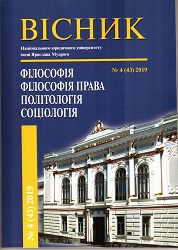ЕВОЛЮЦІЯ КРИТЕРІЇВ КЛАСОВОГО СИМВОЛІЗМУ В СУЧАСНИХ СОЦІОЛОГІЧНИХ ТЕОРІЯХ
THE EVOLUTION OF THE CRITERIA OF CLASS SIMBOLISM IN MODERN SOCIOLOGICAL THEORIES
Author(s): Olena Volodymirivna Volianska, Iryna Valeriivna PidkurkovaSubject(s): History and theory of sociology, Evaluation research, Social differentiation, Social Theory, Social Informatics, Social Norms / Social Control, Globalization
Published by: Національний юридичний університет імені Ярослава Мудрого
Keywords: social inequality; classes; social stratification; criteria for determining the class; social structure; class symbols
Summary/Abstract: Problem setting. Rethinking inequality in the space of globalization processes creates a field of theoretical discussion and empirical researches regarding the criteria for the formation of class dispositions. As experience shows, globalization erases the usual differences between classes and classical instruments for measuring the middle class exclusively by economic and professional criteria (as it was convenient to do in the industrial wave) are no longer suitable, since in the information society the class differentiation of groups is no longer based on symbols of affected consumption, but it often has ideological symbols.Paper objective. This article is devoted to the evolution of sociological views on the problem of social inequality in order to define new criteria for class differentiation and their symbolic meanings.Paper main body. One of the key aspects of the post-social cultural and ideological transformations is the sense of the category of “riches”. The number of categories has become greater and more significant, and economic and political restructuring of the remaining 30 years. The mean value of the category of “reaches” associated with difficult experiences characterized by cultural and social transformations. Today, the middle and upper classes no longer differ in their behavior in the field of consumption.However, class symbols are dynamic, some disappear and some increase. There are three types of career symbols of class status that Е. Goffman recalls in earlier articles. First of all, they can weaken with the group that relies on them. When a former ruling class, which once held privileged economic positions, loses them, it has to declare its dominance, create cultural symbols.The second difficulty with the characters - they are approved by the group. At some point, artists who created content for the aristocracy, begin to despise the bourgeois, and then the bourgeois begin to take pride in friendship with the bohemian and adopt her demeanor. The sociologist Pierre Bourdieu studied the formation of an aesthetic taste for the works of culture. On the large empirical material, Bourdieu showed that aesthetics does not obey any objective set of laws, but conforms to status hierarchies, though not reduced to them.Conclusions of the research. Thus, the social structure of developed societies gradually goes into the shadows, disguising their symbols for indiscriminate consumption. What becomes status is no longer relevant to material things: these are symbols of a certain worldview, an image of an unsightly healthy lifestyle, far from the eyes of Google’s navigation and trendy serial currents. This opens up a new field of debate for social structure researchers regarding methods and tools of measurement.
Journal: Вісник НЮУ імені Ярослава Мудрого. Серія: Філософія, філософія права, політологія, соціологія
- Issue Year: 43/2019
- Issue No: 4
- Page Range: 143-157
- Page Count: 15
- Language: Ukrainian

